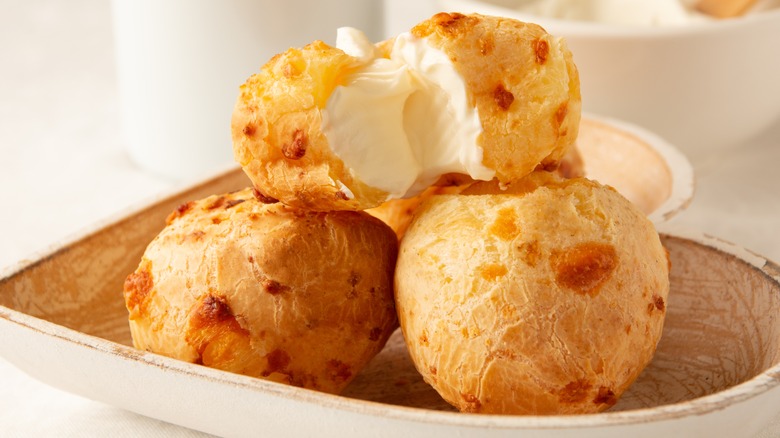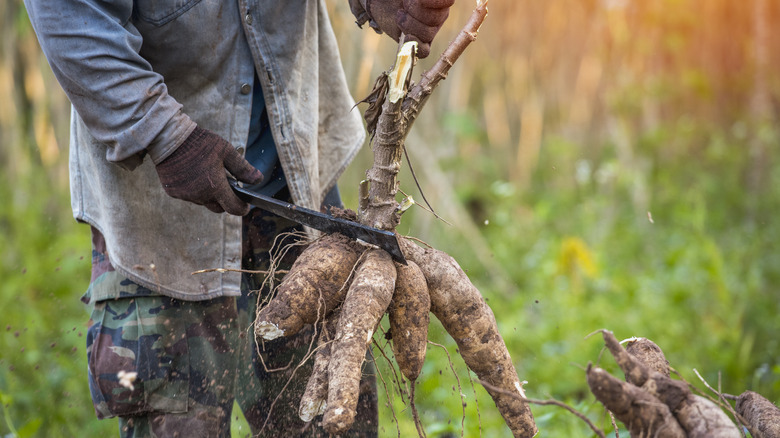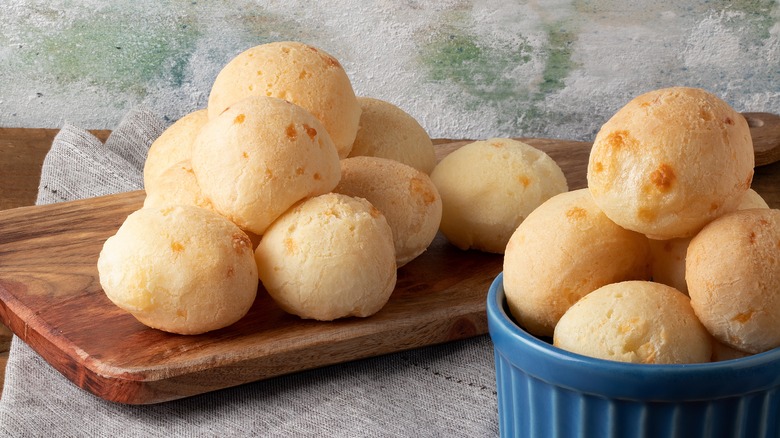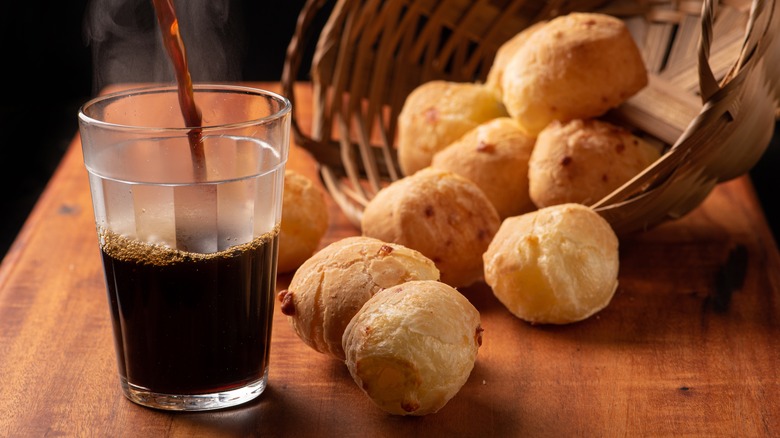What Makes Brazilian Pão De Queijo Unique
We may receive a commission on purchases made from links.
Brazil is famous for its soccer team, churrascaria (a steakhouse where cuts of meat are taken around and served to customers, dim-sum style, via Fathom), pastéis, or their deep-fried take on the empanada, and of course, their world-famous cocktail, the caipirinha, made out of lime, sugar and cachaça, their version of rum.
As for Brazilian bakeries, one only needs to type "Brazilian bread" into Google to find the dominant baked treat of the country: pão de queijo. Pronounced pow-du-KEHjo (per Hilah Cooking), this gluten-free cheese bread comes in the shape of a round ball and has a soft chewy inside and crunchy exterior, making it perfect for easily popping into one's mouth. These Brazilian cheese puffs are easy to make at home, and while it's similar to its French cousin, the savory gougère, the snack bread has a long history behind it that runs parallel to the history of the country itself.
The unsavory history of pão de queijo
According to The Guardian, pão de queijo's roots go as far back as the indigenous Guaraní people of the Minas Gerais region, who used the native yuca and cassava plants to make bread. Much later, in the 16th century, the Portuguese brought enslaved people from Africa when they arrived on Brazil's shores to establish colonies and extract resources. But wheat wasn't native to the lands, and those enslaved were forced to use what they were given, so they would roll the residual starch from processing cassava roots into balls and bake them.
According to the Post Independent, it was later that cheese, which was "considered unfit to eat by their masters" was added to the recipe, and thus the basis for a modern pão de queijo was born. As time went on, pão de queijo continued to thrive: the recipe got refined, substituting in tapioca flour and parmesan cheese, turning it into the beloved treat as it is known today.
How pão de queijo became a nation wide snack and reached the US
Eater reports that former Brazilian president Itamar Franco, who served from 1992 to 1995 (via Britannica) is responsible for popularizing pão de queijo on a national level. According to the book "New Challenges in the Cassava Transformation in Nigeria and Ghana," Franco's fondness for pão de queijo was so extreme that he mandated the cheesy bread be available for consumption at every single government meeting. As a result, national consumption of the snack has grown significantly since.
Today pão de queijo is a symbol of good hospitality, and always present at celebratory life events like birthdays and weddings, according to Cheese Professor. Pão de queijo is so integrated into daily Brazilian life that it can be found fresh in bakeries all day long, and is sold in shops, stands, markets, and even restaurants. Pão de queijo even made it to America by way of Boston sometime around the 1960s with the wave of immigrant Brazilian construction workers.
Ingredients in pão de queijo, how to eat, and and where to buy
In Brazil, pão de queijo is commonly eaten for breakfast or as a snack, and often is enjoyed with coffee or tea (per Amigo Foods). It only takes a half an hour to make, and the ingredient list is short: cassava flour, milk, oil, eggs, salt, and cheese. Cassava flour is interchangeable with tapioca and yuca starch, since they are all derived from the same cassava manioc plant.
While it's fairly easy to find freshly baked pão de queijo in Brazil, it may be harder to find in the U.S. However, thanks to entrepreneurial immigrants who missed the taste of home, there are a few startups that have made enjoying pão de queijo possible by buying the treat frozen. Brazi Bites, of Shark Tank fame, is sold online as well as at grocery stores like Whole Foods, and there are other frozen brands like Say Pao. For those who can't be bothered to make their own pão de queijo from scratch and don't want to just heat them up frozen, Amazon even has an easy mix with a solid 4.5 star rating.



